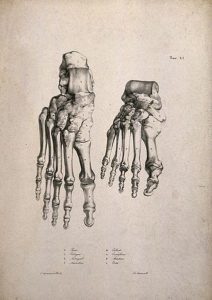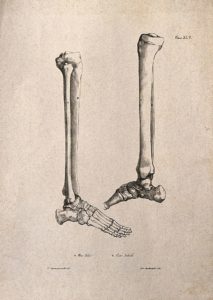The structure of the foot.
There are 26 bones, comprising one-quarter of the bones in the body, in the foot, which can articulate in 33 places.
There are four layers of muscles intrinsic to the foot and over one hundred ligaments responsible for binding the bones together.
Anatomists break the structure of the foot down into three sections: the hindfoot, the midfoot, and the forefoot.
The hindfoot is made up of the calcaneus – the heel –and the talus, which sits on top of, and articulates with the calcaneus.
The midfoot is comprised of five bones — navicular, cuboid, and three cuneiforms. Combined, the seven bones of the hind and midfoot make up the tarsal group of bones.
The phalanges and metatarsals—that is, the toes and the long bones that connect to the midfoot – compose the forefoot.
The structure of the foot includes three arches: the inner, the outer, and the transverse.
One way to imagine an arch is two pillars falling towards each other with a keystone in the middle.
A keystone is a bone that is wider at the top and thinner at the base.
The difference in the foot’s arches is that they are able to flatten and spring back – the spring in your step.
This capacity is one of the unique wonders of the human foot.
The ability of these bones to fix into a solid or vault arch thrusts us forward to the next step.
And alternately, the ability of the bones to articulate through its many joints lets the foot adapts to various terrain.
Energetically speaking, the arches’ capability to flatten, solidify, and spring is crucial to the best use of our muscles and bones.
The inner arch encompasses the calcaneus, the talus, the navicular, the first three cuneiforms, and the first three metatarsals.
The outer arch is the calcaneus, the cuboid, and the fourth and fifth metatarsals.
Finally, the transverse arch cuts across the midfoot and contains the three cuneiforms and the cuboid.
Note how we are essentially splitting the weight of our foot across a triangle of support, with the main weight falling through the inner arch.



